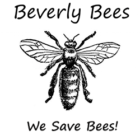The above average March temperatures allowed me to perform an early spring hive inspection of my overwintered colony.
With temperatures above average all winter, and 10-20 degrees above average for the past week, the flowers in the area have started blooming early and the bees have been very active. The temperature today reached 70 degrees Fahrenheit and I took advantage of the warm weather to check my bees. I planned on just taking a quick peek, but I couldn’t help myself and pulling a few frames led to a complete hive inspection. This was the first thorough inspection since November 2011.
When I approached the hive around noon time, the temperature was 65 degrees Fahrenheit and the bees were very busy bringing several kinds of pollen into the hive. There was yellow, pale yellow, bright orange and a greyish-tan color pollen. I believe the orange is crocus which I have seen blooming in the area, and one of the yellow colors may be willow, which are blooming in my yard. One of these days I’m going to get a pollen identification book so I can figure out exactly what the girls are eating.
In the fall, this hive was low on stores so I made a candy board for them to give the bees an extra boost if they needed it. I was curious how much sugar they had actually eaten. After removing the cover, I inspected the candy board. It was heavy and there was still plenty of sugar left for the bees. The bees had scooped out the inside from underneath and had completely consumed one entire pollen patty. There was only a thin sheet of sugar on the top and bottom so it appeared the girls barely touched the candy board, but in fact, they had eaten tunnels through the entire board. There were actually small clusters of bees inside the board that could not be seen unless you looked into the tunnels. It appears they ate 4-5 lbs of the sugar from the board, along with the pollen patty. The board started the winter with 16 lbs of sugar in it.
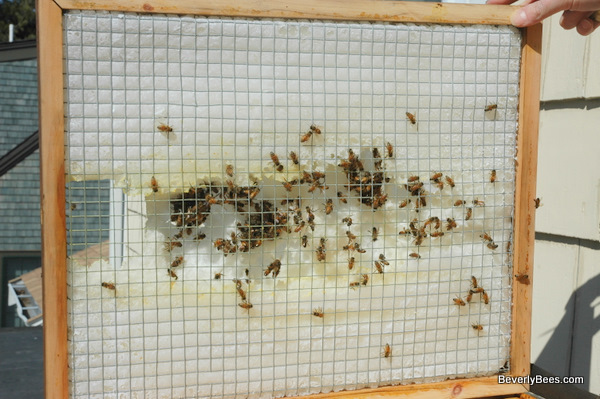
Next I inspected the frames in the top super. I have included a detailed description of each frame and the photos of the inspection in the gallery below. A general overview of the inspection found Frames 1-2 were filled with capped honey and nectar. Frame 3 had some capped honey, nectar, empty cells and a few capped brood. Frame 4 had lots of eggs, larvae, some pollen, a few capped brood and lots of bees. Frame 5 had the queen, eggs, 1-3 day old larvae, pollen and lots of bees. Frames 6-10 had a combination of capped honey on the outside and empty cells in the middle. I also noticed the population was about 1/4 the size it was in the fall. Hopefully many bees were out foraging and the queen will start laying faster.
Here is a comparison picture from the fall. This photo was taken before smoking the bees. It was cold out and the bees were trying to block the air from getting inside the hive.
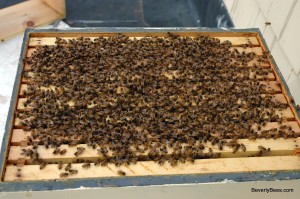 Here is a photo from my inspection yesterday after smoking the bees. The population looks much smaller but many bees were out flying and on the frames in the hive (because I smoked them there).
Here is a photo from my inspection yesterday after smoking the bees. The population looks much smaller but many bees were out flying and on the frames in the hive (because I smoked them there).
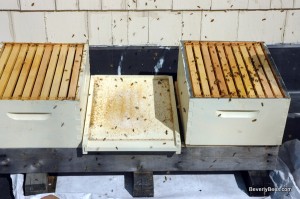 After a thorough inspection of the top super, I removed the tar paper and inspected the bottom super. All the comb was empty except for a half a dozen dead bees that had died while emerging. They probably froze when the cluster moved to far away from them to keep them warm.
After a thorough inspection of the top super, I removed the tar paper and inspected the bottom super. All the comb was empty except for a half a dozen dead bees that had died while emerging. They probably froze when the cluster moved to far away from them to keep them warm.
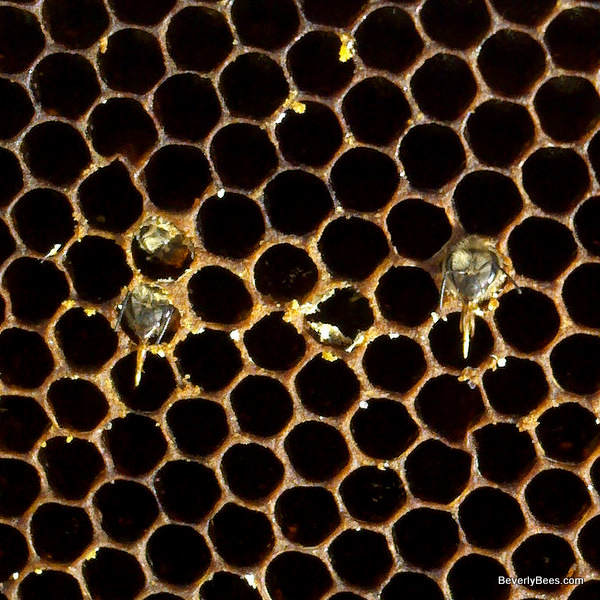
I had suspected the bottom box was empty because the bees were no longer using the bottom hive entrance. They were very crowded going in and out of the top hole. I decided to reverse the supers and put the bottom box on the top, and the top box on the bottom. This will give the queen more room to lay eggs as the bees move up naturally. It will help relieve any congestion inside the hive from honey storage and make going into and out of the hive much easier as the bees start to use both entrances again.
To do this I pried the bottom box off of the slatted rack with my hive tool. There was some sugar and wax paper from the candy board and some dead mites on it. I dusted it off and removed it to clean the bottom board. The bottom board had debris of sugar, wax paper, 5 or 6 dead bees and dead mites about a 1/2 inch thick. I scraped it off with my hive tool and put the hive back together reversing the supers (moving the bottom box to the top and the top box to the bottom).
Then I moved the hive away from the house a few feet and into the spring and summer position in the middle of the roof. It makes it easier to access this way since I can get behind it. I also removed the candy board because the girls have enough honey and I don’t want them to become honey bound. In addition, I removed the insulation from the inner cover. If it cools down I may pop the insulation back in but I didn’t want the bees to eat it (which they had started to do already). A few minutes after the hive was put back together the bees were happily going in and out of both entrances and the traffic jam had cleared up.
The bees were bringing in plenty of pollen but I may supplement them if that slows down because there was not much in the hive. Most importantly, they made it! They survived their first winter intact, the queen is there and laying eggs for spring and that makes me a happy beekeeper.
To see more detailed pictures of my hive inspection view the gallery below. Just click on a picture then scroll through the sideshow.
